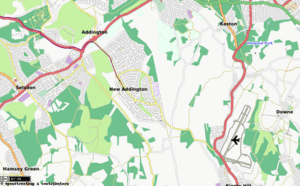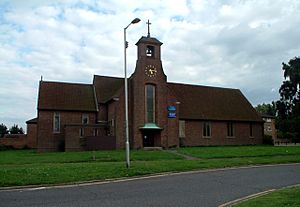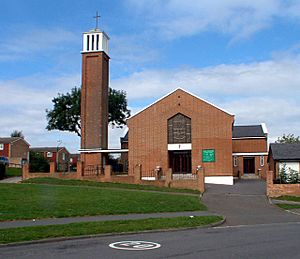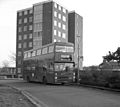New Addington facts for kids
Quick facts for kids New Addington |
|
|---|---|
 Central Parade |
|
| Population | 10,801 (2011 Census. Ward) |
| OS grid reference | TQ382622 |
| • Charing Cross | 12 mi (19 km) NNW |
| London borough | |
| Ceremonial county | Greater London |
| Region | |
| Country | England |
| Sovereign state | United Kingdom |
| Post town | CROYDON |
| Postcode district | CR0 |
| Dialling code | 020 01689 |
| Police | Metropolitan |
| Fire | London |
| Ambulance | London |
| EU Parliament | London |
| UK Parliament |
|
| London Assembly |
|
New Addington is a part of South London, England. It is located within the London Borough of Croydon. This area is about 5 miles (8 km) southeast of Croydon and sits next to the border between Greater London and Surrey.
Contents
A Look Back: New Addington's History
How New Addington Began
Before the 1930s, the land where New Addington now stands was mostly farms and woodlands. It was part of an old parish called Addington. Two of the farms were named Castle Hill and Addington Lodge.
At that time, many people lived in crowded areas in central Croydon and London. To help with this, a group called the First National Housing Trust bought a large piece of land in 1935. They wanted to build a 'Garden Village'. This new village would have 4,400 houses, shops, two churches, a cinema, and a village green. The chairman of this trust was Charles Boot. Because of him, the first part of New Addington is sometimes called The Boot's Estate.
Building Before the War
By 1939, when World War II started, building work had to stop. At this point, 1,023 houses and 23 shops had been built. People liked the new homes, but there were not enough facilities like schools or shops. Residents often had to travel far for work, shopping, or fun. This made the estate feel a bit cut off from other places. Some people even called it Little Siberia because it often felt colder than the rest of Croydon.
Growing After the War
After the war, people worried about using too much countryside for building near London. So, much of the land around New Addington was marked as Green Belt land. This means it is protected from building. The local council, the County Borough of Croydon, bought more land to continue building.
Many small, single-story homes called "prefabs" were built in the Castle Hill area. These were used until the 1960s, then replaced with brick houses. Larger, two-story semi-detached houses were also built. This new building shaped New Addington into what it looks like today.
More houses, flats, churches, and shops were built. The London Borough of Croydon added another 1,412 houses, finishing in 1968. This area, closer to Croydon, is known as the Fieldway Estate. In 2011, the total population of New Addington and Fieldway was over 22,000 people.
New Addington's Community and Challenges
Connecting the Community
For many years, New Addington was quite isolated. Bus services were the main way to get around, but they were not always enough. This made it hard for residents to reach jobs, schools, and a wider range of shops.
A big change happened in 2000 with the arrival of Tramlink. Route 3 connects New Addington to Croydon and Wimbledon in about 30 minutes. From there, people can travel to Central London. This new tram service opened up more choices for schools and jobs. New bus routes were also added to connect with the Tramlink stops.
Community Improvements
The area was chosen as one of the first "Education Action Zones" by the government. This meant extra money and chances for schools to work together. The London Borough of Croydon also put more money into housing and facilities for young people. They also set up a local partnership where residents could help guide improvements in their area.
New Addington has faced some challenges over the years. However, the community and local authorities continue to work together to improve safety and well-being for everyone.
Who Lives in New Addington?
Population Facts
The 2011 census helps us understand who lives in New Addington. In the New Addington ward, about 76% of people were White or White British. About 14.2% were Black or Black British. Other groups included Mixed/multiple ethnic groups (3.8%) and Asian or Asian British (3.4%). The largest single group was White British (72.7%).
Most homes (31%) were rented from the council. About 29% of homes were owned with a mortgage or loan. The average age of people living here was 34. Interestingly, only 0.3% of people in New Addington and Fieldway wards cycled to work. This was one of the lowest rates in Greater London.
The Office for National Statistics says that the New Addington Built-up area had a population of 22,280 in 2011. This number includes both the New Addington ward (10,801 people) and the Fieldway ward (11,479 people).
Local Places and Services
Churches and Worship
New Addington has several places of worship. The main Anglican church is St Edward's Church, built in 1957. Fieldway is part of the older Addington parish, which has the 11th-century St Mary the Blessed Virgin Church. There is also a Baptist church, the Good Shepherd Roman Catholic Church, and a Salvation Army centre, along with other smaller places of worship.
Phone and Post Codes
Most of Croydon uses the London telephone code '020'. However, New Addington often uses the Orpington code '01689' for BT customers. If new customers get a cable phone line, they might get an '020' number. New Addington is in the CR0 postal district, which is one of the largest in the country by population.
Future Plans for Central Parade
Since 2006, Croydon Council has been talking with the local community about improving the Central Parade shopping area. They want to work with a partner to build new homes and a supermarket.
Getting Around New Addington
Train Connections
The closest National Rail stations to New Addington are Hayes, which is about 3.6 miles (5.8 km) away, and East Croydon, about 5 miles (8 km) away.
Tram Services
The area is well-served by three Tramlink stops: Fieldway, King Henry's Drive, and New Addington. These trams connect the area to West Croydon and Wimbledon.
Bus Routes
New Addington has several London Buses routes. These include routes 64 (which runs 24 hours), 130, 314, 464, and 664 (a school route). These buses connect New Addington to places like Biggin Hill, Bromley, Croydon, Eltham, Hayes, South Norwood, and Thornton Heath.
Gallery














